Take a deep breath and then relax. It would demand a very long essay to give you all 10,000 reasons, so I’ll limit myself to 10. Besides some of the reasons date back to the ancient Pythagoreans and are ultra, ultra secret. There was the delightful British fiction that every Victorian gentleman owned both a microscope and a telescope. Ah, if only that had been true and even more Ah (or Ah-er) if every citizen of every country had the opportunity to own a microscope and secondarily a telescope as well. Secondarily, because the nights up here at 7,200 feet get quite cold in the winter. The coldest one I remember was -39 degrees Fahrenheit.
Some few marvelous, visionary individuals have undertaken a project which might just make it possible for virtually everyone to own a microscope. A brilliant innovator, Manu Prakash at Stanford University, has, along with his research team, created the Foldscope, an “origami” microscope which costs only a few dollars. It is surprisingly versatile, completely portable, and can provide both children and adults the opportunity of discovering hidden dimensions of the world around them. There is a beautiful passion behind this project and in some interesting ways has parallels to the ambitious musical projects of Gustavo Dudamel and the children’s orchestras.
Albert Schweitzer said that cats and music make life bearable. I would add microscopes to that list because:
Reason #1. Microscopes give us access to realms of wonder in the world around us that, because of their size, remain largely hidden.
Reason #2. With a microscope, even a very simple one, we can observe organisms that until the 17th Century were completely unknown. Marvelous creatures that are so intriguing that some individuals, who having once glimpsed them have devoted the rest of their lives to studying them. It’s pretty impressive that a group of micro-organisms could produce such fascination and dedication.
Reason #3. If you’re clever, charming, handsome or beautiful, you may not need a microscope to seduce your girl or boy friend. However, if you’re rather on the ordinary side, like most of us, being able to show off the beautiful intricacies of the micro-world, such as, birefringent crystals under polarized light, might reveal your sensitivity, insightfulness, passion, and quiet humility. That might make you irresistible. Don’t bet large amounts of money on it, but don’t discount it either.
Reason #4. A microscope provides you with a special opportunity to investigate the properties of light and discover the incredible ways in which it can be manipulated to reveal aspects of specimens that you never dreamed of. The human eye is more sensitive to certain parts of the visible spectrum than others. However, a note of caution is appropriate here; this is a generalization which has very real applications, but doesn’t take into account variations in individual people who may have certain visual anomalies which may lead to differences of perception and interpretation. Nonetheless, we operate in terms of norms; in order, hopefully, to maximize our attempts to communicate successfully with each other and establish common ground; that is, fundamental points of reference.
That said, most individuals can notice an increase in contrast and detail in specimens by the simple placement of a green filter in the light path. This is often employed in conjunction with phase contrast. With brightfield, a blue daylight filter is often used to produce a color balance that is more consonant with our usual visual expectations.
Reason #5. Having a microscope allows you to explore special optical enhancement techniques which can satisfy those who revel in tinkering with bits of apparatus which can be challenging and rewarding and can appeal to individuals who are primarily interested in exploring new possible ways of observing specimens. Such techniques can reveal aspects that might otherwise remain hidden. One of the most accessible and rewarding techniques is the use of polarized light. One can begin very simply by using relatively inexpensive material cut from cheap polarizing sun glasses or even better from a sheet of polarizing material which you can purchase from surplus houses and camera supply stores. This has the advantage of allowing you to easily cut filters to sizes to fit your needs. Take a Vitamin C tablet, shave off some bits, dissolve them in water, and then make same slides. Let them dry until you get a nice distribution of crystals. Put them under your microscope and observe them first with brightfield and then put the polarizing filters in the light path. Now you have something to write home about! If you’ve prepared your samples properly, then you should experience a wondrous variety of shapes and colors.







This may lead you to acquire a specialized polarizer and analyzer for your particular microscope. (If you buy used ones, make sure there isn’t any delamination in the filters.) Talk about a stimulus to curiosity! As you inevitably begin to explore more and more crystalline substances or birefringent biological structures, you run the risk of becoming entranced, as I did, and seeking out more sophisticated accessories, such as, a rotary polarizer, and then ultimately on to a dedicated polarizing microscope. Some years after I retired, I realized that I was taking more and more photomicrographs of birefringent specimens and I finally succumbed and purchased a used Zeiss polarizing microscope (in pristine condition, from a dealer I trust implicitly–a crucial factor!).
Among other benefits, it has brought me great joy. It expanded my knowledge about many types of specimens and certain types of optical techniques, but the greatest significance has been the number of “Oh WOW!” moments which this fine instrument has provided. To experience such exciting beauty is a transformative experience which most people never encounter. So they should have microscopes to awaken their sensibilities!
Reason #6 There are other light-altering techniques with a microscope which can be mind-altering without the side effect of hallucinogens. Take the example of primary fluorescence. By means of the use of appropriate filters, one can get a glimpse into a striking new dimension of nature without having to use any dyes on the specimen. We all know that chlorophyll is green. Or is it? Under blue-light fluorescence, unstained green algae and desmids show up as bright red. Well, which is it “really?” you ask indignantly. If you did a poll of honey bees, you find that they vote, virtually unanimously, for red. Humans, on the other hand, vote virtually unanimously for green unless they happen to be color blind. As it happens, many insects are sensitive to the ultraviolet spectrum and so, a bee’s-eye view of a bed of flowers is quite different than ours.
Most types of specimens do not exhibit primary fluorescence and so techniques using a wide variety of fluorescent dyes are used to stain specimens. They are then observed with ultraviolet light using the appropriate filters. One of my favorite stains is Acridine Orange which is also a mutagen and astonishingly produced some specimens of Lacrymaria with 3 heads and necks in cultures treated with dilute solutions of that dye. Interestingly, we start with an orange dye and most of the stained structures appear neon-green under U.V. fluorescent microscopy which is used in a wide variety of techniques in medical pathology.
Reason #7. Sometimes we all want to “correct the imperfections of reality”, such as getting rid of corrupt politicians but, unfortunately even the best microscopes cannot make that happen, but we can get creative in terms of altering contrast and color in our microworlds and this can provide an enormous aesthetic satisfaction. There is a relatively simple and inexpensive technique called Rheinberg illumination after Julius Rheinberg, a 19th Century British microscopist, who popularized and promoted the technique. It’s brilliant in its simplicity and versatility. You can begin with some cheap sheet of color plastic, but I would recommend that you invest a bit more and purchase a small selection of colored filters with good color saturation. An inexpensive swatch book is provided by some dealers with an amazing variety of colors. The swatches are only about 1" x 3", but perhaps large enough to carry out a few experiments. Some dealers used to offer such swatchbooks at no cost. This evening I looked up a sample and found a dealer offering the swatch book for $0.01, yes, one cent. I went on to check out the shipping cost of this nifty little item–$17.39!–ah, the delights of modern marketing. Some years ago, I bought a book of the large filters, 3" x 5", which provided sufficient material to make many, many filters Alternatively, you can go on eBay and order from a dealer who makes prepared (pre-cut) filters for a variety of microscopes and filter holders. I found them to be a very good purchase and they are time- and frustration-saving.
So, what’s the big deal about a bunch of colored filters, you might ask.

There are a number of fine articles on Micscape about Rheinberg illumination dealing with both theory and practice which you can find by doing a search on “Rheinberg.”
Another technique which allows one to do extraordinary things with contrast and color is Differential Interference Contrast (DIC). The most popular form is Nomarski DIC. It demands some quite specialized equipment which is rather expensive, but the results are remarkable. This is a technique which uses special prisms, one of which can be rotated. It also employs polarized light. The precision of differential interference is such that it can produce a kind of optical staining which, as it were, allows you to look at a suitable specimen as a series of layers. Also, by varying the position of the prisms, one can achieve optical staining. This combined with the enhanced contrast can produce some stunning results.
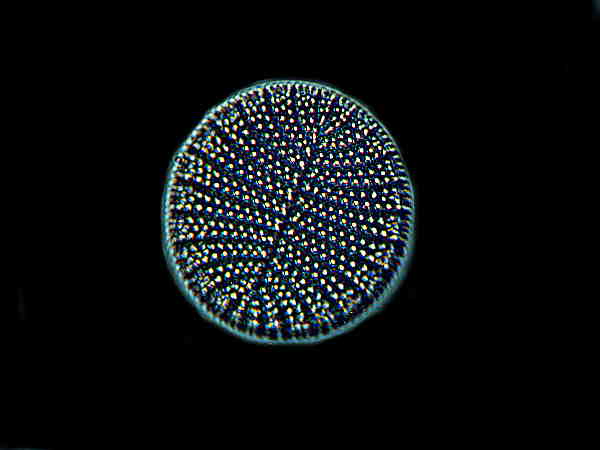
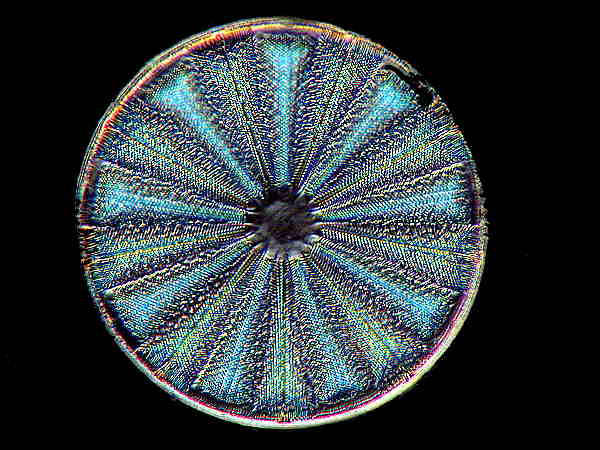
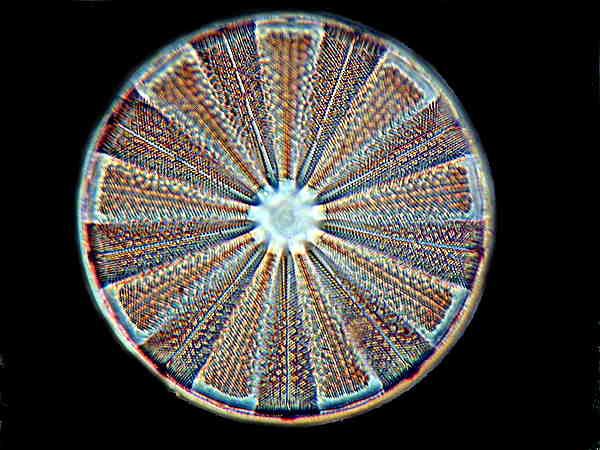
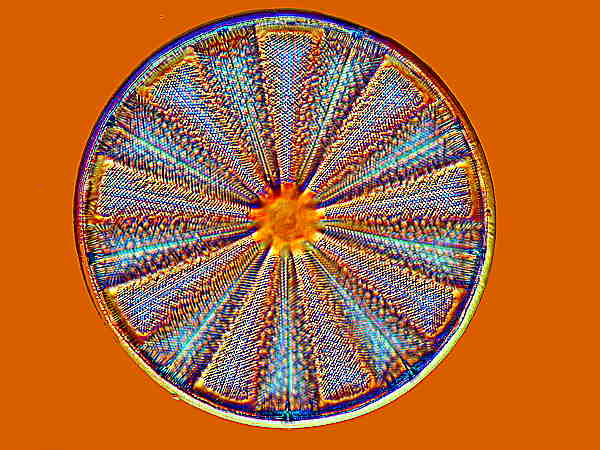
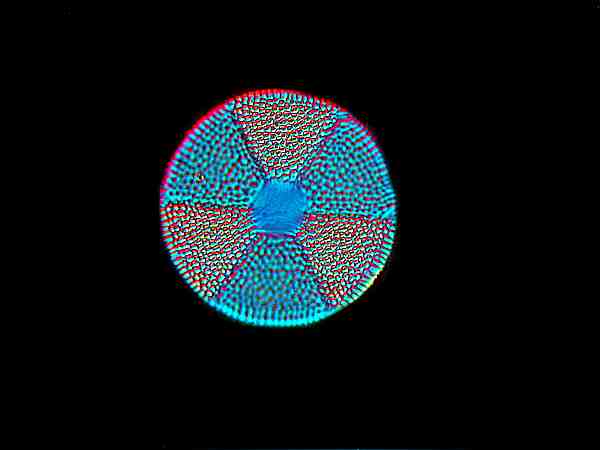

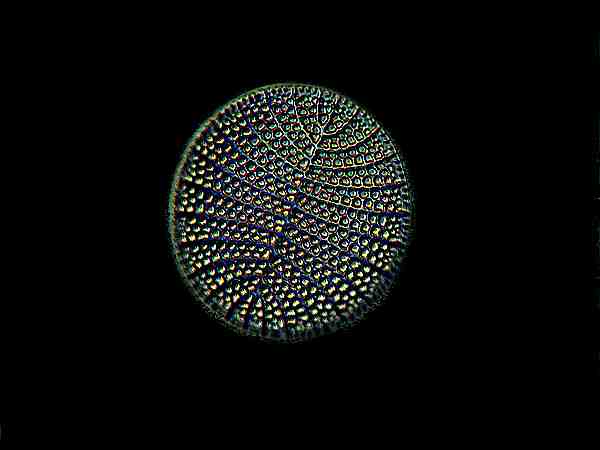
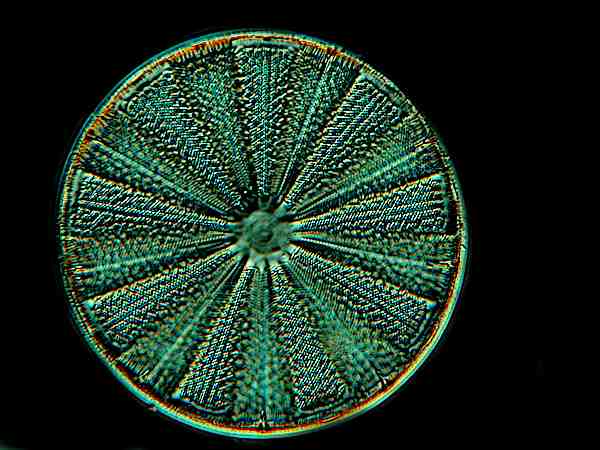
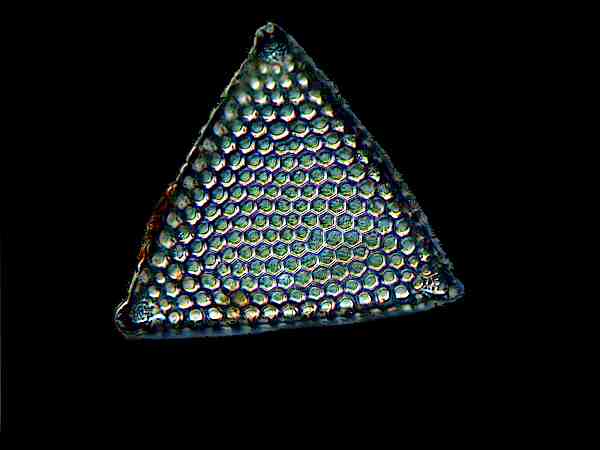
This is rather like being an “optical painter” since these techniques provide you with a palette that you can alter in intriguing ways. So, using Rheinberg or Nomarski can unleash your creative sensibilities and with the powerful graphic software packages now available, the kinds of transformations you can achieve are almost endless. Some purists argue that one should only present images of a specimen that show it “as it truly is”, what ever that means. The fact is that we are constantly altering and interpreting what we see in ways that call attention to facets of the object that can allow us a better understanding of it. On the other hand, there are those who are more interested in creating special effects than providing insight into the nature and structure of the specimens. I take a middle ground position, I like all three positions as long as the photographer is honest and doesn’t misrepresent what he or she is doing.
Reason #8. Statistically biologists tell us that there is an extraordinary number of organisms which have not yet been discovered and described. I will leave it to you and them to determine how they arrived at this claim, so I am prepared to go along with it, although I admit that I get a bit nervous when they start attaching numbers to these claims–HEADLINE: 500,000 Species Of Beetles Not Yet Discovered! A strange claim at best.
Nonetheless, we do suspect that there are indeed lots of organisms out there waiting for us to come along and give them a name and a biography. This notion of large numbers of undiscovered species seems especially probable in the realm of micro-organisms. It is another reason to own a microscope–you might discover a new species. Imagine the overwhelming excitement, joy, and wonder of the first person to ever see a Volvox, that magical, beautiful, green sphere rolling through a drop of water. As it happens that person was Leeuwenhoek in the year 1700.
Had I been the one to have made that discovery, my wig would have popped right off my pate! It is very unlikely to expect that one might discover an organism as grand as Volvox but, nonetheless, you might discover an organism with extraordinary characteristics or a bizarre life cycle or peculiar morphological facets and that could indeed be exceptionally exciting and gratifying. However, finding such an organism these days would require a lot of searching and hard work, luck, careful documentation and independent verification. My view has always been that every organism that I hadn’t seen before is a new discovery and therefore, a source of pleasure and excitement and, although I know that this particular beastie is described and perhaps even well-known, it was not known to me and so, there is the fun of tracking it down, identifying it, and finding out what others have to say about it. To me, this has been a highly rewarding approach, because
a) I frequently come across organisms I haven’t previously encountered.
b) It stimulates my curiosity and provokes me to learn a great deal from others who have investigated this organism.
c) There is also the possibility that I might just discover some new property or behavior of this organism and while that would certainly not rank with discovering a new species, it would, nonetheless, be quite satisfying.
d) To me, as an amateur, a crucial aspect involves exploring all kinds of things in nature that surround us and have, all too often, become commonplace so that we intend to ignore much of the world. All around us are wonders and mysteries which can enrich our lives throughout our entire lives. As I poke and prod into the natural world, I find that my curiosity intensifies and leads me into ever new dimensions of the world of nature on this strange and amazing planet.
Reason #9. Beauty Knowledge, and Sex
“Beauty is the beginning of a terror we can just barely endure and it calmly disdains to destroy us.” –Rainer Maria Rilke (translated by McIntyre)
Many Victorian writers extolled the beauty of Nature and often in a religious context which they claimed revealed the great and wonderful mysteriousness of God. However, Nature, as viewed by cynics such as myself, is also filled with horrors, at least from my human–all-too-human perspective. I am not inclined to write odes of joy to such beings as the Ebola virus. And then there are the hideous parasites that attack and disable us, amoebas which can invade the brain producing a lethal type of meningitis, worms that attack the eye and produce blindness or other ones that produce elephantiasis, and the list goes on and on. And then there are the predators who mostly kill for food and survival, but there are also some that seem to kill for “pleasure” and, at the top of that list, are human beings.
Over the centuries, many philosophers, poets, playwrights, painters, and sculptors have presented us with visions of that dialectical tension between beauty and horror. Immanuel Kant in his Critique of Judgment presents a concept of the sublime which is precisely this mixture of beauty and terror. An ocean can be an entity of great beauty and yet underneath that surface is a potential destructive power of enormous dimensions which has no consciousness, no conscience nor compassion and will indiscriminately crush both those whom we count as evil and those we count as virtuous. Just consider the recent tsunamis. This awe is the phenomenon of wondrous terror.
The Romantic in us can be inclined to focus almost exclusively on the extraordinary glory and variety of Nature to the extent of our being willing to overlook or rationalize the negative. On the other hand, the Cynic in us can obsess over the monstrous and hideous aspects of Nature. This becomes largely a matter of temperamental dominance and, ideally, I would embrace a synthesis that we might whimsically label Romanti-cynicism. The saving grace in the rapture between rapture and horror is, I think, the ability to maintain a perspective of humor about Nature and ourselves as a part of Nature. A microscope can help facilitate that process Whenever I observe the hypotrich Urocentrum turbo, I am amused and mildly frustrated as I zero in on one to photograph it and it whips off out of the field of view. It was sitting there spinning while attached, wonderfully illustrating the appropriateness of its name only to whirl off leaving only a frustrated would-be photomicrographer. In retrospect, surely a comic scene which perhaps teaches the small lesson that we have very little control over most natural phenomena.
Or consider viewing a slide of the nematocysts in the tentacles of a sea wasp, an extremely dangerous cuboid jellyfish. These structures are remarkably intricate in both morphology and function and yet potentially lethal even to humans if there are sufficient “stings” from these toxic “needles”. Nevertheless, we can be impressed and admire them insofar as we are not subjected to their not-so-tender ministrations. And, even here, there is a sort of comic dimension to the fact that a small, glassy, being composed mostly of water can bring down a human being with dispassionate indifference and not even be able to indulge itself in an egotistical self-celebration of its achievement. In short, Nature is utterly indifferent to us, our existence or non-existence is a matter of total unconcern. Nonetheless, we are irresistibly attracted to the marvels of Nature, the riot of colors, forms, and behavior–and surely our lives would be much bleaker without such marvels.
And then there is the matter of SEX–oh, yes, every biologist worth his or her salt is fascinated by the variety and intricacy of reproductive mechanisms In Nature. Violating mathematical principles, there is multiplication by division, not to mention, addition by multiplication. Then there is the naughty hermaphroditic snail who adds its own kinky refinement by means of “love darts” to stimulate the genital area of its mate (or its husband and wife). And then there are those outrageously radical feminist, Cladocerans, who allow only the female. There are indeed species where no males have ever been detected! So, reflect on that you macho males, you might be irrelevant in the longer scheme of things. Reflect on how in the last 3 or 4 decades the number of female biologists has skyrocketed–clearly, there is an elaborate conspiracy developing (at least, according to certain politicians. (“Watson, the game is afoot.!) And then there is the female mantis who after sex devours the male. Or the abyssal female angler fish who utterly enslaves the male. The male is much smaller and attaches in the area of the genital pore and she then grows skin around him so that he cannot escape and she provides nutrition through her body, but he is reduced to being a “sex slave”. Also, the glorious Volvox presents us with unusual models. It produces sexual colonies within the larger colonies and in some individuals the subcolonies are exclusively male, in others exclusively female (see, this is a conspiracy with very deep and ancient roots), and yet other colonies which have both male and female subcolonies. Surely, this is the grand prix display of sexual diversity. Well, not quite, there are some protozoa which have 6 or more sexes among them, some of the fascinating Hypermastigina which are multiflagellates of extraordinary diversity and are found in the gut of certain species of termites. Just image the confusion, nay, chaos, if we humans had 6 distinctly different sexes. But this is not the end of micro-perversity. Biologists have discovered what are called “mating types” in a variety of protozoa. Much research relating to this phenomenon has focused on Paramecium tetraurelia. The organism can reproduce by dividing about 150 times and then it needs to conjugate with another individual of its species and a complementary mating type and thereafter genetic repair which has transpired allows the organism to again reproduce about 250 more times and then again start its quest for a suitable mating type. No one knows how many times this cycle can be repeated. Furthermore, nobody knows how many mating types there might be; however, it has been documented that there is a strain which uses an insidious device to strive for dominance; it possesses Kappa particles which during conjugation are transmitted to non-Kappa strains and proves lethal to them. Many life lessons can be learned from the reproductive strategies of micro-organisms!
Reason #10. Perhaps the most important reason to own a microscope is two-pronged. First of all, it allows one to test and continually develop ones individual abilities and skills and establish a richer interaction with aspects of oneself. It further allows one to develop an enhanced understanding of ones critical, analytic, and creative urges and to vastly expand and reinforce the driving force of curiosity. I am always deeply disturbed when I encounter individuals who have little or no curiosity about the natural world of which they are a part and upon which their existence depends.
The second prong is the communication and sharing of ones passions and excitements with others. While there is excitement and much joy to be derived from ones solitary investigations, there is often even much more when one has the opportunity to share ones passions, be they with friends, colleagues, children curious about Nature, acquaintances who are members of a microscopical society, or with a slice of the general public by means of a lecture and/or slide show or demonstration. There is, what one might call, an “amplification factor” when one encounters a sympathetic spirit who can “ooh” and”ah”over the same things that excite you. And there is the additional factor that your friend or acquaintance may introduce you to new, unfamiliar microscopic dimensions spurring you into new areas of inquiry.
All comments to the author Richard Howey are welcomed.
Editor's note: Visit Richard Howey's new website at http://rhowey.googlepages.com/home where he plans to share aspects of his wide interests.
Microscopy UK Front
Page
Micscape
Magazine
Article
Library
© Microscopy UK or their contributors.
Published in the December 2018 edition of Micscape Magazine.
Please report any Web problems or offer general comments to the Micscape Editor .
Micscape is the on-line monthly magazine of the Microscopy UK website at Microscopy-UK .
©
Onview.net Ltd, Microscopy-UK, and all contributors 1995
onwards. All rights reserved.
Main site is at
www.microscopy-uk.org.uk .